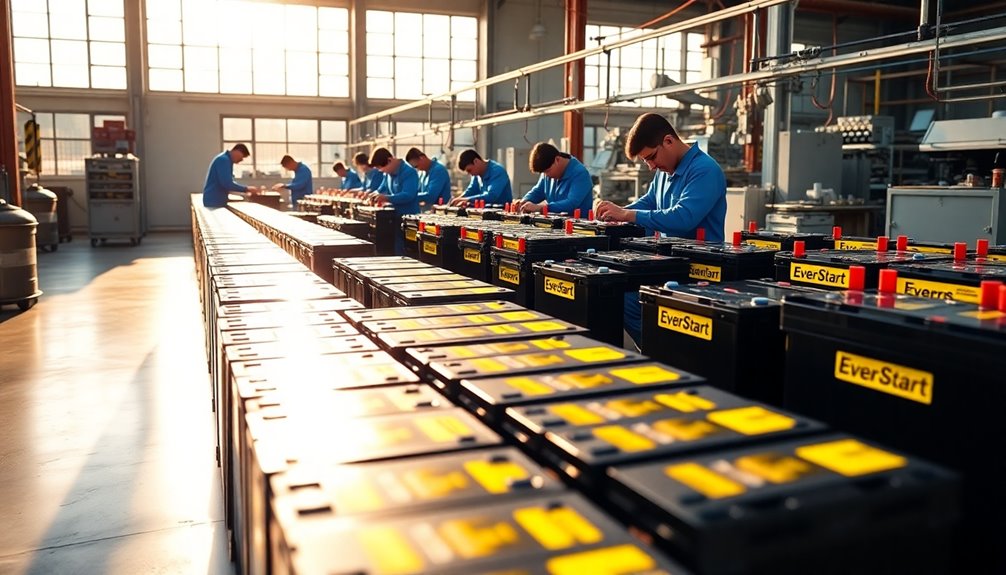The top five mergers shaping the future of the battery industry are driving industry transformation by consolidating resources, strengthening supply chains, and boosting innovation. These deals help companies control raw material sourcing, improve sustainability, and reduce costs, making products more reliable and eco-friendly. By focusing on supply chain stability and advanced recycling, these mergers position the industry for rapid growth and resilience. Continue exploring to see how these strategic moves are setting the stage for a sustainable energy future.
Key Takeaways
- Major industry mergers streamline operations, boost market share, and enable better control over raw material sourcing.
- Consolidations foster integrated supply chains, enhancing raw material security and sustainability practices.
- Mergers accelerate recycling technologies, reducing dependence on raw material mining and lowering environmental impacts.
- Industry-wide mergers increase capacity, reliability, and innovation in battery chemistries and manufacturing.
- Strategic alliances improve supply chain resilience, supporting the transition to sustainable, clean energy solutions.

As the demand for high-performance, sustainable batteries accelerates, major mergers are transforming the industry’s landscape. These strategic consolidations are not just about increasing market share; they’re reshaping how companies approach supply chain integration and raw material sourcing. You’ll notice that with fewer players dominating the scene, companies can streamline their operations, reduce costs, and improve the reliability of their supply chains. This is especially critical given the increasing scarcity and geopolitical complexities surrounding raw materials like lithium, cobalt, and nickel. When companies merge, they often pool resources to secure more stable and diversified sources of these essential materials, reducing vulnerabilities caused by supply disruptions or price volatility. This consolidation means that instead of fragmented sourcing efforts, you get more cohesive strategies that emphasize direct relationships with mining operations or long-term supplier contracts, ensuring a steady flow of raw materials needed for battery production.
From your perspective as a consumer or investor, these mergers mean greater transparency and reliability in the supply chain. Companies now have the leverage to negotiate better terms and develop integrated logistics networks that cut down lead times and mitigate risks. This level of control over raw material sourcing isn’t just about cost savings; it’s about sustainability as well. You’ll see a stronger emphasis on environmentally responsible sourcing practices, with merged entities often committing to ethical mining and reduced ecological impact. These collaborations also help accelerate innovation in recycling technologies, further closing the loop on raw material needs and diminishing environmental footprints.
Furthermore, supply chain integration resulting from these mergers enables companies to better coordinate production schedules, optimize inventory management, and respond more swiftly to market demands. As a result, you benefit from more consistent product availability and potentially lower prices. It also allows for accelerated research and development efforts, as pooled resources can be directed toward next-generation battery chemistries and manufacturing techniques. The focus on securing raw materials and streamlining supply chains ultimately positions these merged companies to lead the transition toward cleaner energy solutions, making the entire industry more resilient and adaptable. Additionally, advancements in solar energy and wind energy technologies are increasingly supporting the renewable energy infrastructure needed for sustainable battery production and charging solutions.
In essence, these mergers are not just about market dominance—they’re about creating more robust, sustainable, and efficient supply chains. As a stakeholder, you can expect a more integrated approach to raw material sourcing, which is crucial for meeting the growing global demand for advanced batteries. This strategic realignment helps ensure that the supply of critical raw materials keeps pace with technological advancements, setting the stage for a future where high-performance, eco-friendly batteries become more accessible and reliable.
Frequently Asked Questions
How Do Mergers Impact Battery Innovation and Technology Development?
Mergers can considerably boost battery research and innovation hubs by pooling resources, expertise, and technology. When companies combine, they often accelerate development, leading to faster breakthroughs in battery technology. You benefit from these advancements through improved energy storage, longer-lasting batteries, and innovative solutions. Mergers foster collaboration, streamline research efforts, and create stronger industry leaders, ultimately driving the future of battery innovation and ensuring you have access to more efficient, reliable energy solutions.
What Regulatory Challenges Do Battery Industry Mergers Face Globally?
Imagine steering a maze of towering walls—this is what battery industry mergers face with global regulations. Trade policies can act as gatekeepers, limiting cross-border deals, while environmental regulations are like unyielding guardians demanding sustainable practices. You must carefully maneuver through these hurdles, ensuring compliance without losing momentum. These challenges require strategic planning, as each move impacts future innovation and the industry’s ability to grow amid shifting legal landscapes.
How Do Mergers Influence Competitive Dynamics in the Battery Market?
Mergers substantially impact competitive dynamics in the battery market by boosting market dominance for larger players, which can stifle smaller competitors. They also foster strategic alliances that drive innovation and efficiency. As a result, you might see increased pricing power and reduced competition, prompting other companies to seek new partnerships or differentiate themselves through technology. Ultimately, these mergers shape the landscape, making it more consolidated and strategically aligned for future growth.
What Are the Long-Term Sustainability Implications of These Mergers?
You should consider that these mergers can boost supply chain resilience, helping you access more sustainable materials and improve efficiency. However, they might also raise concerns about environmental impact if larger companies cut corners or prioritize profits over sustainability. Long-term, these mergers could either enhance or hinder sustainability efforts, depending on how well companies balance growth with eco-friendly practices and responsible resource management.
How Do Mergers Affect Pricing and Consumer Access to Batteries?
Mergers act like a double-edged sword, shaping how you see prices and access. They often reduce competition, leading to higher prices and less consumer affordability. But sometimes, they can streamline production and innovation, potentially lowering costs. Ultimately, these mergers influence price competition, making it either a battleground that benefits you with better deals or a fortress that limits your options. Your access to affordable batteries depends on how these market shifts unfold.
Conclusion
These mergers are like powerful currents shaping the battery industry’s ocean. By joining forces, companies are steering innovation and sustainability toward a brighter, more energetic future. Staying aware of these shifts helps you understand how your devices will power up tomorrow. Just as a strong river carves new paths, these collaborations carve the way for groundbreaking advancements, ensuring you stay ahead in a world increasingly driven by energy and technology.










